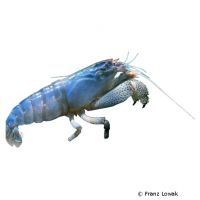African Giant Filter Shrimp (Atya gabonensis)
| African Giant Filter Shrimp Atya gabonensis | |
|---|---|
| Name | African Giant Filter Shrimp |
| Name Lat. | Atya gabonensis |
| Family | Shrimps |
| Family lat. | Atyidae |
| Order | Decapoda |
| Order lat. | Decapoda |
| Origin | West Africa, South America |
| Habitat | Streams, rivers |
| Diet | Omnivore |
| pH | 6.5-7.5 |
| Behavior | Peaceful |
| Keeping | Group |
| Care Level | Moderate |
| Reproduction | Marine larval stages |
| Breeding | None reported |
| Life Span | 6-10 years |
| Protection | No |
| Metric Units | |
| Size | 10-14 cm |
| Temperature | 24-28 °C |
| Hardness | 5-20 °dH |
| Aquarium | 100 l |
| US Units | |
| Size | 3.9"-5.5" |
| Temperature | 75-82 °F |
| Hardness | 89-356 ppm |
| Aquarium | 25 gal |
Distribution and habitat
Gabon giant fan shrimp are found in both West Africa and northern South America in coastal, fast-flowing river channels, to depths of 10 meters.
Maintenance
They require a well-structured aquarium with many roots, some robust plants, large stones and boulders, and strong current. The substrate of sand or gravel should be partially covered with foliage (e.g. sea almond leaves, oak leaves), rotting plant material and mulm.
No ammonia, ammonium and nitrite should be detectable in the aquarium water, the nitrate value should not exceed 100 mg/l. To ensure the water quality and oxygen content, a filter and heater adapted to the size of the aquarium is required, as well as lighting for the species-appropriate day-night rhythm of the animals. When choosing the filter, special care should be taken to ensure that the animals cannot be sucked in.
Diet
In nature, they filter detritus, zoo and phytoplankton, and tiny insect larvae from the water with their scissor legs formed into fans. They are easily fed with cyclops, daphnia, artemiauplia, microworms, spirulina and finely ground shrimp food supplemented with dried, crushed nettle, oak, beech and walnut leaves
Unaccepted food must be vacuumed up after 2-3 hours. Regular and varied feeding promotes health and prevents deficiency symptoms.
Behaviour and compatibility
They should be kept in a group of at least four. During the day they usually stay hidden. Due to their special feeding habits they are no danger for other shrimps or fish and are well suited for a community tank. Sometimes there are harmless fights among each other for the best places in the current.
Basically, only compatible animals with similar demands on water quality and water temperature should be socialized.
Reproduction and breeding
Males have significantly larger anterior walking legs than females, whose abdominal carapace is extended downward
Larval development takes place in seawater. Breeding in the aquarium has not been successful so far.
Important
The different appearing colorations might be origin-dependent. In the aquarium, especially after moulting, white specimens have also appeared. This probably happens as a result of missing trace elements
If the animals frequently scan the bottom with their fans, then they receive too little food in the current.
A socialization with crayfish is not recommended, because they could injure the shrimp after molting.
The well-being of the animals should be checked regularly. The temperature should be checked daily, the pH, hardness and nitrate value at least every 14 days. Regular partial water changes are recommended, even if the contaminant level has not yet reached the upper limit. Sudden changes in water quality should be avoided. Newly introduced animals must be accustomed slowly to the water in the aquarium.
Further literature can be found in your pet store.
References
Text: petdata; Image: Franz Lowak
Source KARGE & KLOTZ (2007): Süßwassergarnelen aus aller Welt, Dähne Verlag; ENGELMANN & LANGE (2011): Zootierhaltung - Tiere in menschlicher Obhut: Wirbellose, Verlag Harri Deutsch
